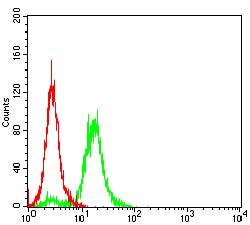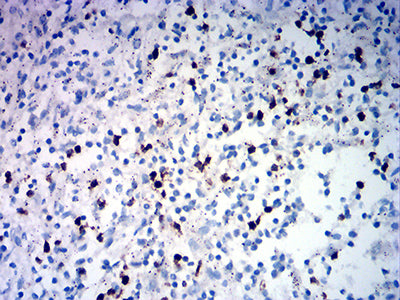


| WB | 咨询技术 | Human,Mouse,Rat |
| IF | 咨询技术 | Human,Mouse,Rat |
| IHC | 1/200 - 1/1000 | Human,Mouse,Rat |
| ICC | 技术咨询 | Human,Mouse,Rat |
| FCM | 1/200 - 1/400 | Human,Mouse,Rat |
| Elisa | 1/10000 | Human,Mouse,Rat |
| Aliases | TCRB; TCRBC1; BV05S1J2.2 |
| Entrez GeneID | 28639 |
| clone | 5A8A10 |
| WB Predicted band size | 19.7kDa |
| Host/Isotype | Mouse IgG1 |
| Antibody Type | Primary antibody |
| Storage | Store at 4°C short term. Aliquot and store at -20°C long term. Avoid freeze/thaw cycles. |
| Species Reactivity | Human |
| Immunogen | Purified recombinant fragment of human TRBC1 (AA: 1-149) expressed in E. Coli. |
| Formulation | Purified antibody in PBS with 0.05% sodium azide |
+ +
以下是关于TRBC1抗体的3篇参考文献概览:
1. **《A novel anti-TRBC1 antibody for flow cytometry-based T-cell clonality assessment in mature T-cell malignancies》**
- **作者**:Maciocia et al. (2020)
- **摘要**:研究报道了一种新型TRBC1特异性抗体在流式细胞术中的应用,用于检测成熟T细胞恶性肿瘤中的克隆性T细胞群。通过分析TRBC1的单克隆表达,该方法可有效区分良性增生与恶性T细胞淋巴瘤。
2. **《Development of a TRBC1-targeted antibody for diagnostic discrimination of T-cell neoplasms》**
- **作者**:Bourdage et al. (2019)
- **摘要**:该文献描述了一种高灵敏度的TRBC1抗体的开发,结合流式细胞术可快速识别克隆性T细胞群,为T细胞淋巴瘤的早期诊断提供了一种新型工具,并验证了其临床实用性。
3. **《TRBC1 as a biomarker for clonal T-cell populations in cutaneous T-cell lymphoma》**
- **作者**:Morice et al. (2018)
- **摘要**:研究利用TRBC1抗体的免疫组化染色技术,在皮肤T细胞淋巴瘤(CTCL)中评估T细胞克隆性,证明其在区分肿瘤性T细胞与反应性浸润中的潜力,支持其作为辅助诊断标志物。
这些文献均聚焦于TRBC1抗体在T细胞克隆性检测及淋巴瘤诊断中的技术开发与验证。
The TRBC1 antibody targets the T-cell receptor beta constant region 1 (TRBC1), a component of the T-cell receptor (TCR) complex expressed on the surface of T lymphocytes. The TCR consists of alpha/beta or gamma/delta chains, with ~95% of mature T cells expressing alpha/beta TCRs. TRBC1 is one of two constant region genes (TRBC1 and TRBC2) in the TCR beta locus, enabling clonality assessment since each T cell expresses only TRBC1 or TRBC2. This feature makes TRBC1 a valuable marker for distinguishing monoclonal T-cell populations (e.g., malignancies) from polyclonal reactive T cells.
TRBC1 antibodies are widely used in flow cytometry and immunohistochemistry to detect clonal expansions in T-cell lymphoproliferative disorders, such as T-cell lymphomas. Unlike genetic clonality assays, TRBC1 staining provides rapid, cost-effective identification of clonal T cells by revealing restricted TRBC1 or TRBC2 expression. Recent advancements in monoclonal antibody development have improved specificity, allowing better discrimination between neoplastic and normal T cells. TRBC1 antibodies also support research on T-cell development, immune responses, and TCR signaling. Their clinical utility continues to grow, particularly in precision diagnostics and minimal residual disease monitoring.
×